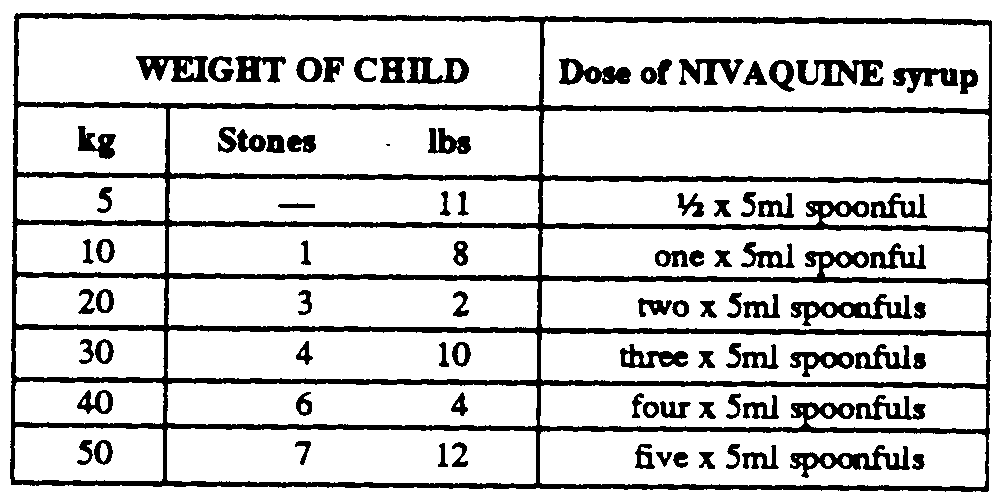Information for the Patient
NIVAQUINE™ SYRUP 100 ml
(Each 5 ml contains 68 mg Chloroquine Sulphate BP
equivalent to 50 mg chloroquine base)
WHAT YOU SHOULD KNOW ABOUT NIVAQUINE SYRUP
This leaflet should be read carefully before you start to take the syrup as it is a summary of important information about the medicine. This leaflet also gives additional advice on how to avoid being bitten by mosquitos. If you have any questions, or are not sure about anything to do with your treatment, ask your doctor or pharmacist for more information.
ABOUT THIS MEDICINE
- This medicine is called NIVAQUINE (chloroquine) Syrup.
- Each 5 ml of syrup contains 68 mg of chloroquine sulphate and the following inactive ingredients: sugar, sodium L-glutamate, saccharin sodium, propylene glycol, methyl hydroxybenzoate, propyl hydroxybenzoate, peppermint oil pineapple flavour and caramel. It does not contain any dyes.
- Chloroquine is one of a group of medicines called anti-malarials but it is sometimes useful for other conditions also.
- This package contains 100 ml of NIVAQUINE Syrup.
- The product licence of NIVAQUINE Syrup is held by: May & Baker Limited, Eastbourne, England BN21 3YG and the product authorisation by May & Baker Limited, Dagenham, England, RM10 7B. NIVAQUINE IS manufactured by: Rhône-Poulenc Rorer Pharma, St Genis Laval France.
Why has my child been given NIVAQUINE Syrup?
NIVAQUINE is usually given to help prevent your child getting malaria. Malaria is spread by mosquitos. Some mosquitos carry the malaria parasites and can infect your child with them if they bite your child - it can take up to a week or more to develop malaria after an infected bite . NIVAQUINE can help prevent your child getting malaria when your child has been bitten by a mosquito. Like other similar medicines, in some cases NIVAQUINE will not give complete protection against malaria. It is, therefore, important you follow all other medical advice.
Make sure that you have told your doctor or pharmacist which countries you are visiting. In some parts of the world the malaria parasites are not affected by chloroquine. If your child has been given another anti-malarial medicine to take with NIVAQUINE, then you must follow the separate directions for it.
Sometimes your doctor may have prescribed NIVAQUINE for treating other conditions. Please contact your doctor if this is the case.
If your child is already taking NIVAQUINE or medicines called "Avloclor" or "PIaquenil" for another condition consult your doctor.
Keep this leaflet for reference until your child has finished taking the medicine.
Before your child takes NIVAQUINE Syrup
If the answer is YES to any of the following questions you should discuss the matter with your doctor or pharmacist before your child takes any of the syrup.
- Is your child taking any other medicine?
- Does your child have any of the following illnesses - liver or kidney illness, epilepsy, psoriasis, blood disorders or neurological disorder?
- Has your child ever had a severe or allergic reaction to NIVAQUINE or chloroquine on taking it before?
Even if you are breast feeding and taking NIVAQUINE this will not protect your baby against malaria. It is important that you discuss this with your doctor.
How should my child take NIVAQUINE Syrup?
It is very important that your child takes NIVAQUINE syrup properly. If your child does not take enough, he/she has a greater risk of developing malaria.
NIVAQUINE is a trade mark 56/69/28
If your child takes too much, he/she may develop side effects
- The dose for children depends on their weight
- Weigh your child, preferably, in kilograms.
- Use the table below to show the correct dose.
- For example, if your child weighs 20 kg (about 3st 2lbs) the dose of NIVAQUINE Syrup is two x 5 ml spoonfuls ( 10 mls).
- When the weight of your child lies between two weights on the table use the lower dose. For example, if your child weighs 25kg the correct dose is two x 5ml spoonfuls ( 10 mls) of NIVAQUINE syrup.
- For doses less than 5ml your pharmacist can supply you with a syringe to measure out the NIVAQUINE syrup.
- When you have worked out the dose, do it again to make sure you have done it properly.

Do not be tempted to give your child the syrup more often unless your Doctor or Pharmacist tells you to.
- Your child should take the dose on the same day each week
- If you will have a problem remembering to give the syrup to your child, ask a friend or a relative to remind you. Writing the day your child should take the dose in your diary or on a calendar may help jog your memory.
- When your child arrives home he/she should continue to take the dose of syrup once a week for 4 weeks. You must remember to be sure that your child keeps taking the syrup when you are at home-even if your child feels perfectly well. Malaria can develop some time after being bitten by a mosquito. If your child stops taking the syrup this will increase the risk of developing malaria when you are at home.
- If your child forgets to take the syrup, it must be taken immediately you remember and then continued as before.
- If your doctor has prescribed another medicine to help prevent malaria your child may need to take this medicine more often than NIVAQUINE. Follow the instructions carefully.
- If your child has to take NIVAQUINE for a long period of time, for example a year or more, consult your doctor who may decide to carry out a few simple test on your child.
What other measures must I take to reduce the risk of
developing Malaria?
Like other anti-malarial medicines, NIVAQUINE does not give guaranteed complete protection against malaria. Your child should also try to avoid being bitten by mosquitos by doing the following:-
![]()